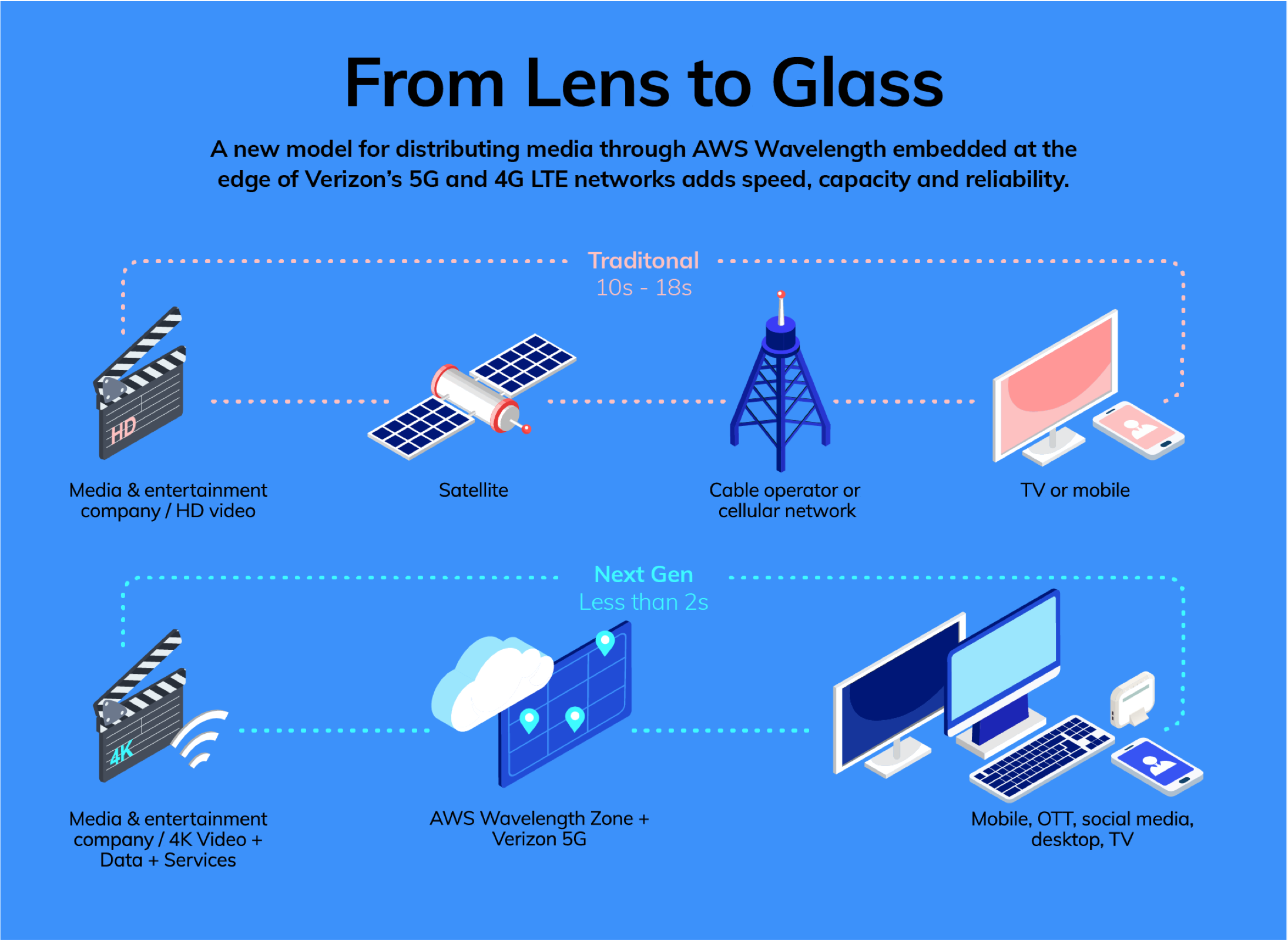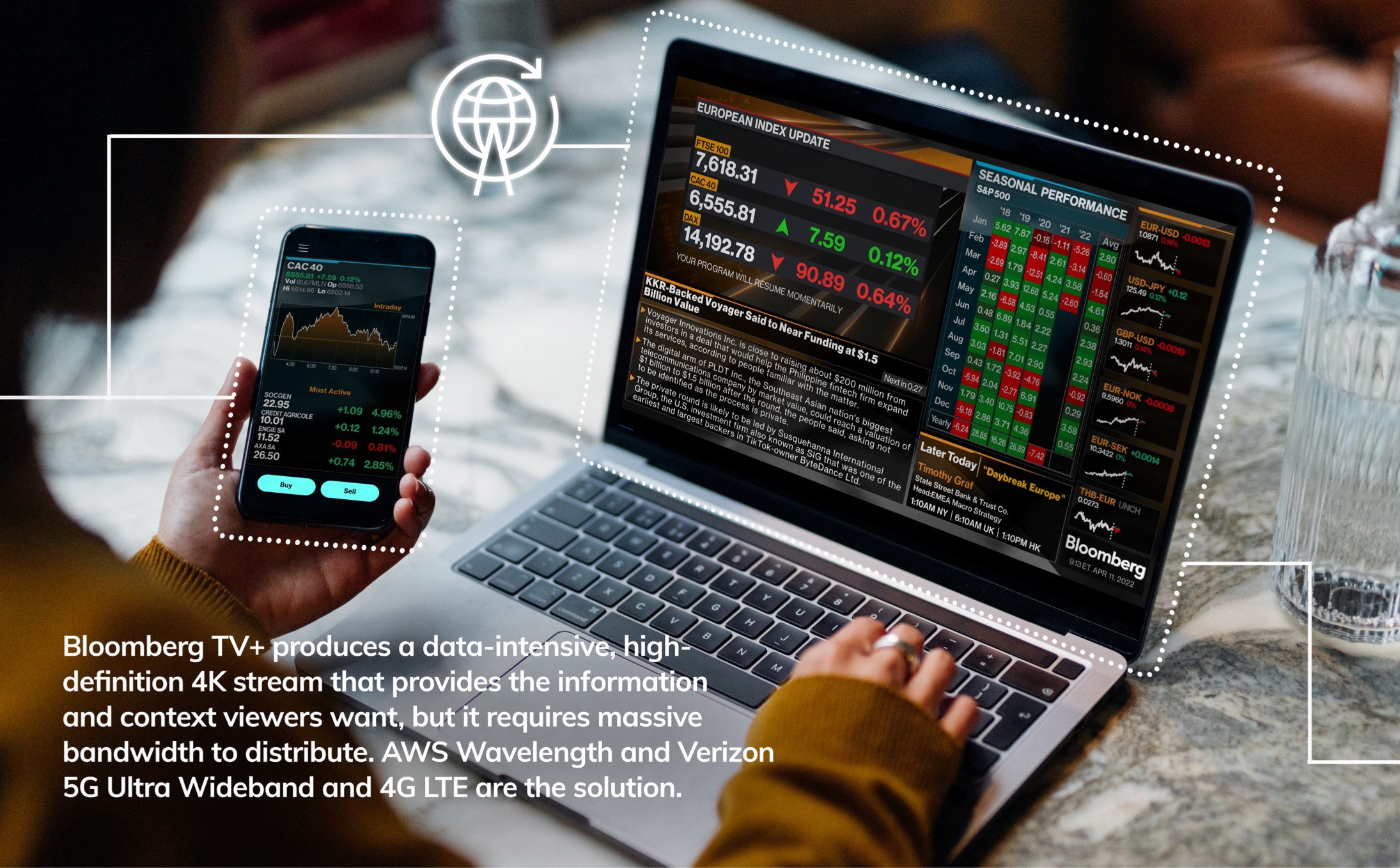Welcome to the New World of Media and Entertainment
AWS and Verizon have teamed to create a cloud-based 5G solution for distributing content that will revolutionize the way you consume media.
Content is king. Five billion videos are watched on YouTube every day, and 300 hours of video are uploaded every minute. The media and entertainment industry continues to grow the amount of content it delivers each year, and that trend will surely continue. But the high volume is already stressing a distribution network whose legacy technology is becoming as outdated as the VCR.
Media and entertainment companies are producing increasingly immersive content across multiple formats, from scripted programs to newscasts. Consumers love the expanded choices—and they want their media wherever and whenever, without delay or interruption, on any device. That’s especially true at Bloomberg Media, where every day, 2,700 journalists produce over 5,000 stories that can move financial markets. If Bloomberg viewers and users can receive breaking headlines and critical financial market data earlier than elsewhere, then investors are able to quickly trade ahead of the competition. In a global financial system where every millisecond counts, the faster delivery of Bloomberg news and data can result in increased investment and business success.
To thrive, Bloomberg Media needs to get its news and rich data content out across its platforms quickly. Legacy systems that rely on satellite relays and multi-point distribution are functional, but AWS (including Compute powered by Intel® Xeon® Scalable processors) and Verizon technologies are providing new opportunities that improve speed, reliability and reach.
That’s why Bloomberg partnered with AWS and Verizon to test a future distribution model in which Bloomberg leverages AWS infrastructure and Verizon’s 5G Ultra Wideband and 4G LTE networks to deliver content through the internet to the edge of the cloud, where it connects with the ultrafast broadband 5G network for delivery to distributors and end users.

“We’re always having conversations with vendors and service providers like AWS to help Bloomberg Media be the most innovative 24/7 global finance and business information company in the world,” says Roman Mackiewicz, Bloomberg Media’s Chief Information Officer. “We are looking for two things: First is finding an alternate way to reach the same places that we reach via satellite today, which is really a transport issue, and second, how do we get the services that we’re currently running in the cloud a lot closer to the delivery point, which is important for us from a performance and latency standpoint.”

AWS and 5G providers join forces
The solution to Bloomberg Media’s distribution challenge is AWS Wavelength combined with Verizon 5G Ultra Wideband. AWS Wavelength embeds AWS compute powered by Intel® Xeon® Scalable processors and storage services to run at the edge of Verizon’s 5G and 4G LTE networks, providing mobile edge computing infrastructure for developing, deploying and scaling ultra-low-latency applications.
The implications for how the media and entertainment industry will distribute content in the coming years are massive. In the current system, when viewers watch Bloomberg TV, the broadcast is encoded into a digital signal and beamed to a satellite, where a cable provider grabs it and beams it down to its facilities and affiliates. Then it gets decoded, repackaged and sent out to a TV cable box or a modem that transmits it to a computer, or to a cell network that transmits radio waves to phones and other mobile devices. The time from “lens to glass”—from a camera shooting a live video until it appears on screens—currently averages 10–15 seconds, depending on device, network and location.

Revving up content delivery for a data-rich future
In the test being conducted by Bloomberg Media, AWS, Verizon and software-defined video platform Zixi, Bloomberg TV+ will send its data-intensive, 4K, ultra-high-definition signal to AWS Wavelength Zones that process, repackage and distribute the digital stream. Since AWS Wavelength is embedded at the edge of the 5G network, the handoff to Verizon’s network is nearly instantaneous.
“You’ll get it faster than you would via satellite or via the cable provider because you’re skipping a couple of steps to get to the picture,” says Mackiewicz. How much faster? “We’re aggressively targeting an experience that would be less than two seconds, lens to glass,” he says. This tremendous speed would clearly benefit investors, who look for millisecond trading advantages to buy or sell ahead of the competition.

Because the signals are not traveling back and forth to satellites in orbit, but instead through the internet and the ultra-high bandwidth of Verizon 5G Ultra Wideband, AWS Wavelength opens up content possibilities much greater than simply watching TV on a phone. “We’re looking at how this serves our customers better,” says Mackiewicz. “Someone who’s following the markets, following business trends, they don’t just need a bunch of talking heads to show up in front of them saying, ‘Oh, this just happened, and this just happened.’ They want more context to go with it.”
The volume of content is only growing as producers continue to add more features—and customers come to expect them—and AWS Wavelength aims to future-proof distribution with speed, reliability and rapid scalability.
“Adding capacity on the 5G network or on the IP network is relatively easy and inexpensive,” says Saravanan Shanmugam, Global Lead Solution Architect, Edge Computing at AWS. “Cost savings, faster distribution and also more features and functionalities in the future for doing processing at the edge are the core tenets of the Bloomberg Media use case.”
Dreaming up new forms of media and entertainment powered by AWS
AWS is looking past simply delivering TV as we know it today. The possibilities of AWS Wavelength combined with 5G or a wired connection open doors for radically new experiences—everything from virtual-reality business meetings to holographic games that can be played inside a self-driving car, to real-time interactions in the metaverse.
“How can we deliver more immersive content to users?” Shanmugam asks. “The connected stadium is another massive opportunity—the fans coming to the stadium, the fans who are right outside the stadium and the fans at home. They want to actually experience the content, not just on a 2D screen anymore, but in a VR or AR mode, where they want to be inside the stadium in a virtual environment.”
Industry-transforming projects such as the Bloomberg Media partnership with AWS and Verizon provide a glimpse of those possibilities. “When you look at AWS, we have an ever-growing list of 200-plus services,” says Shanmugam. “New services and innovations are being developed every day on behalf of our customers as we think bigger about the future.”

Amazon Web Services (AWS) hybrid solutions seamlessly extend the same AWS infrastructure, Intel® powered compute, services and tools in the cloud, on-premises, and at edge locations. Intel® processors provide the foundation of many hybrid and edge computing services deployed on AWS. Amazon Elastic Compute Cloud (Amazon EC2) instances powered by Intel® Xeon® Scalable processors have the largest breadth, global reach, and availability of compute instances across AWS geographies. AWS and Intel’s® 15-year relationship is continuously dedicated to developing, building, and supporting services that are designed to manage cost and complexity, accelerate business outcomes, and scale to meet current and future computing requirements.


